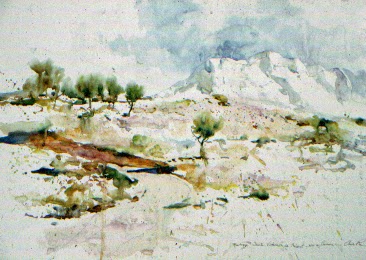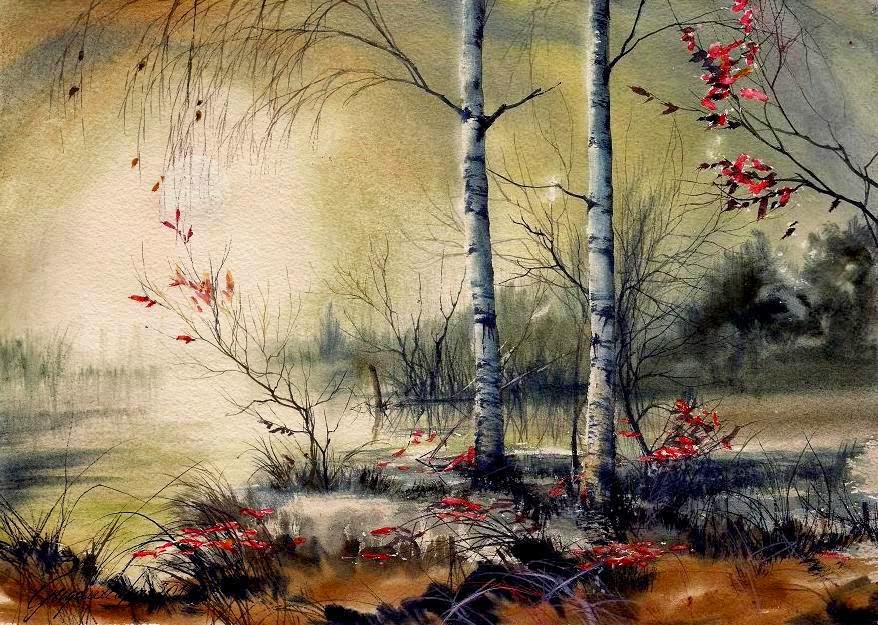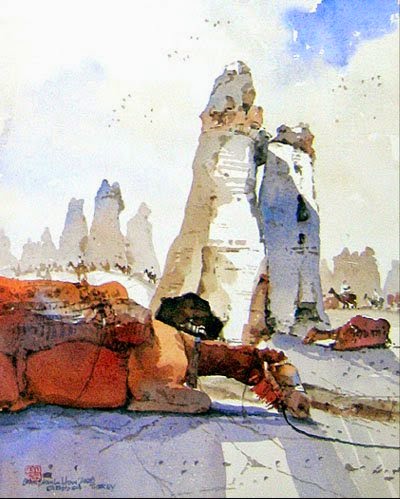"
the very best and most expensive watercolour brushes are made from the winter tail hairs of Mustela Sibirica, called in the art world a Kolinsky, but sometimes referred to as a Siberian Mountain Weasel - although there seem to be a lot in China, seen often in Beijing, where it is called a `Yellow Rat Weasel'. I believe `rat' is in the name because it kills rats, and traffic will sometimes stop in Beijing to let one across the street because of this propensity........brushes are also made from Martes zibellica, called a marten, and from `Kazan Blue Squirrel' (and a few other Russian squirrels) which I have not been able to identify.....The problem I want to address, to put it bluntly is that there is a lot of cheating and obfuscation going on in the brush market mostly around kolinsky brushes which, as I have said, are very expensive - running in the hundreds of dollars...."As the weasel family is quite large, and not all confined to China and Russia, Canada and Korea for example are another source of tail hair, then it seems likely other similar species are involved but presumably expert brushmakers can determine what is genuine and what isn't. Can they? Does it matter if the species are very close? If marketed as genuine Kolinsky the answer is yes.
The above but one paragraph is an extract of an e-mail published on Wetcancas from the collections manager of the mammal department of the American Museum of Natural History in New York, so I have assumed, he knows what he is talking about.
The Kola Peninsula in Siberia. Is this the only place where genuine Kolinsky sable hair was once obtained? Are any weasels of the right species still living or are they extinct? I have read that they are `endangered' or alternatively (see above) running about the streets in Beijing! Who or what to believe?
According to the excellent blog Channeling Winslow Homer Mustela Siberica has long been trapped to extinction in Siberia and other species of weasels - similar in many ways - are used instead. It would seem therefore that the use of `Kolinsky' is largely a misnomer. A bit like Cheddar cheese. www.channeling-winslow-homer.com
Most sources say the finest hair is from the male animal and should be harvested at a particular time of the year - the Siberian Winter is normally quoted. However Wikpedia says that `most brushes have a mix of about 60/40 male-to female hair'.
Another piece says:
`Manufacturers obtain the hair for their brushes from hair dealers, who, in turn, get hair in a rough state (pelts, tails, etc) through the fur industry. The hair dealers `dress' (de-grease- clean etc) the hair, grade it, and bundle it by size and weight. A brushmaker is then offered the different grades and mixtures. If he is not careful, however, he may unknowingly receive summer coat instead of winter coat, or other hair mixed in with the Kolinsky hair.'
I could go on and on as there is a mass of information to delve into but where do you end? The final buyer, ie us artists, haven't a clue as to whether we are getting the genuine article or not. All reputable brushmakers claim that they use `the very finest' hair and so they may or indeed think that is what has been supplied.
Rosemary of Rosemary & Co says:
`like most things the better the ingredients and raw materials the finer the end result. Beware of the less expensive so called `sable brushes. many contain little or no genuine sable at all regardless of what it says on the handle. Others may contain sable hair which hasn't been `dressed' properly or indeed sorted by length.'
What to make of all this? My response is a great deal of scepticism since we all know that all is not what it seems and even well-known companies cannot be 100% relied upon. I'm not suggesting they deliberately mislead, but when we see what is and has happened in other spheres why should the art world be any different?
Now to the brushes. I can only comment on my own limited experience but perhaps point you in the right direction when making choices. There are many brushmakers and the ones I know most about are European. I know little or nothing about those in America, Asia or elsewhere. If any readers would like to share their experiences I'd be delighted to add them to this piece.
Winsor & Newton Series 7
Where do we start? To my mind Winsor & Newton series 7, which are the most expensive sables of the lot. Winsor & Newton are no longer the famous British company of old, having been sold first to a Swedish Company and then most recently to a German one. They've even moved manufacture of the artists watercolours to France. Are the old traditions being maintained? The ether has been thick with innuendo and rumour about W & N for sometime, the general drift being that standards have slipped and quality is not what it was. This applies to brushes and paints. Some of this may well be misinformation spread by jealous rivals but it does make you wonder when you look at the way the company has been hawked around. Frankly the prices of series 7 are ridiculous and I wouldn't contemplate buying them when such excellent brushes are available at much lower prices. See what Rosemary says in her catalogue in the questions and answers section.
![]()
The above illustration comes from the excellent website of Dakota Brushes
www.dakotabrushes.com/ I cannot recommend this website highly enough for the mass of useful information. Detailed statistics on all the makes above with brushhead diameter and length given for every size so that you can easily see which - at least in volume of hair - are the best buys. Highly informative and a good source of brushes in North America.
Let us first of all look at sizing. The above are all size 8 but as you can see there is considerable variation. Winsor & Newton claim their series 7 are up to two sizes larger than most other makes but in the above comparison the one that stands out is Da Vinci, while Escoda who are being heavily promoted by a number of high profile artists, is easily the smallest but comparable to Isabey. Naturally price comparisons have also to be made in association with actual size. In that respect Escoda don't fare too badly.
The above are three Da Vinci series. It appears the numbering may vary in different markets.
This is from the excellent website of Luxartis run by the wife (I believe) of the artist Jake Winkle. They claim the brushes are longer and slimmer than most other makes. I purchased a No.8 which is yet to be christened but examination of it didn't seem to validate their claim.
www.luxartis.biz/
From top to bottom: SAA Kolinsky 10 (made I'm told by Raphael), Da Vinci Maestro 10 series 10, SAA Size 8, Escoda 1212 Size 10, Da Vinci Maestro 8, Luxartis 10.
As you can see there is considerable variation in the actual size of the brush head. Raphael look pretty good and so does Da Vinci. Since I did this I obtained some Isabey brushes and like them a lot. They are on the small side size wise but long and slim.
![]()
Rosemary offers a wide range of sable brushes, listed as either Kolinsky or red sable. She maintains she uses the best quality hair, as all the leading makers do, and her comprehensive range is well worth investigating. This includes some nice travel brushes. I have had a number of her brushes over the years. The most popular sable range is Series 33 and many good artists swear by them. I purchased a sable mop some time ago and regretted it ever since. It was under the previous ABS label but as the Rosemary range is identical (with additions) to the ABS one then I imagine the current mops are similar. Why don't I like it? It certainly doesn't point well and is useful only as a wash brush. You can get good wash brushes for a lot less than £50. I think the one I bought was too large for my purposes. I have found that brushes from ABS and Rosemary can vary. Some are splendid but others have been less satisfactory. I have heard claims that `they don't point well' from some artists I've met but others love them. You can't really compare Series 33 with the top of the range Da Vinci, Raphael and Isabey, all of which are much more expensive. Rosemary does a top of the range Series 22 which is comparable, certainly in price. With a superb catalogue, enormous range and excellent worldwide service, Rosemary brushes are well worth considering.
www.rosemaryandco.com
Raphael, who are French as are Isabey, make a wide range of `Kolinsky' sables. They have several types of round with different characteristics. The best source I know is Great Art
www.greatart.co.uk, whose website gives full details of the range. My SAA brushes remain pristine as does a Raphael Series 8404 size 8 so I have yet to us them. Gilles Durand, a fine French professional artist who I met on several Charles Reid workshops said they lost their point after about six months. The brushes look good to me but prices are steep.
Da Vinci, a German company but - I am told - with no connection to the American paint maker Da Vinci, are a favourite and recommendation to his students for many years from Charles Reid. They make excellent brushes. So far I've only used the Artissimo 44 Kolinsky mop Size 2. This is roughly equivalent to a 14 in the normal type. I like it a lot but recently the hair became detached from the brush head! the whole head just popped out! Fortunately I was able to put it back in again but this is not good for a brush costing £50 or so.
Escoda the Catalonian company are making a stir with a high profile marketing campaign using some very well-known workshop artists. They market an increasing number of sets - usually three brushes - with the artists name on the handle. Escoda are a good company and well worth considering. Some of these artists go over the top with their claims that Escoda are `the best in the World'. Good certainly but best in the World? I doubt some of the others would concede that and neither do I, although I do think they are excellent brushes.
This is only a snapshot of what is available. Pro Arte, better known for synthetics, make an expensive Kolinsky range. Both Winsor & Newton and Daler Rowney have other sables, some classed as `less expensive'. I have heard good reports of the Israeli Rekab brushes and so on. Art suppliers have their own label Sable or Kolinsky brushes and more seem to be appearing. It is bewildering and also confused by variable reports from different artists.
I asked my good friends Michael Carney and John Softly on their views. Mick prefers Da Vinci and Raphael but was not impressed with the Windor & Newton series 7. He has had mixed experiences with Rosemary brushes, rather similar to me it would seem. John is cynical about `Kolinsky' and believes most if not all so-called Kolinsky brushes are not genuine. After my research so am I, although it seems there are several species of weasel that are very similar.
ABS (now Rosemary) Eskdale, 8, 10, 12, & 14 plus W & N Series 7, 3,4 & 7
John has 38 in total, I must be close to that figure (!), a mixture of ABS Eskdale, Roymak, Escoda and Series 7. I don't know Roymak, but some of them date back 15 years or more and still point well. For an extensive amount of information on brushes as experienced by members try Wetcanvas, then Watercolor, then The Learning Zone and search for `Brush reviews'. This is particularly applicable to the experiences of American members. You can find out much more if you are interested by `googling' around.
Now to pricing. Taking Jacksons
www.jacksonsart.co.uk as a fairly reasonable guide the following prices are current, all size 8. Escoda 1212 £13.20p, Raphael 8404 £22.50p, W & N Series 7 £105, Isabey £29.25p, Jacksons Tajmir (made by Escoda) £11.00p, Jacksons Kolinsky £14.60p, Da Vinci Maestro 10 £26.50p, Da Vinci Maestro 35 £30.30p. Rosemary Series 33 £12.75p and Series 22 £29.95p. Once past size 8 prices leap into the stratosphere. The dearest Series 7 is a 10 at £151.00p! Da Vinci Maestro Series 10 go to a huge Size 50 (who would want such a thing?) at an incredible £1024.00p. Escoda make an 18 at £115.60p, Raphael; a 16 at £113.00p and Isabey a 14 at £101.20p. Rosemary makes a size 24 in series 33 at £450.00p and a series 22 in size 20 at £517.50p. Eyes watering and head spinning yet?
As you can see there is quite a variation from the ridiculous £105 of W & N - how they get away with it I just don't know - to the £11.00 of Jacksons own brand. As I've highlighted earlier size is only a rough guide as brands vary since there is no recognized industry standard so this is also a factor in deciding what to buy.
The final question. Do you need to buy sable brushes, whether they are called Kolinsky, red sable or just plain sable to produce good paintings. The advantages of sables are said to be much better water retention and controlled release of paint plus control over brush strokes. However despite these qualities the answer is NO and if you read what some of the fine artists I've featured use you will see this is so. The real key is the hand that controls the brush. Okay I'm a brush freak but that's just me.
I think I'll end it there.
































